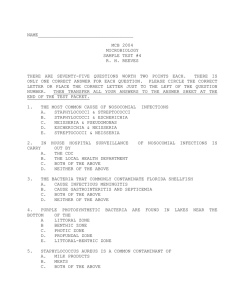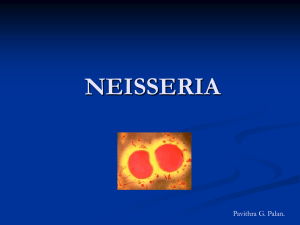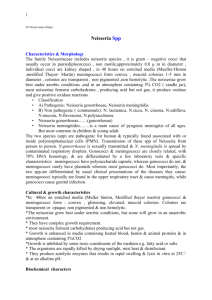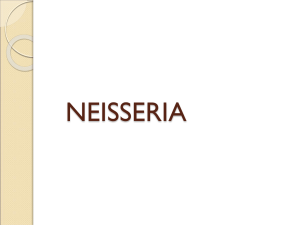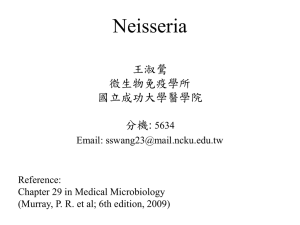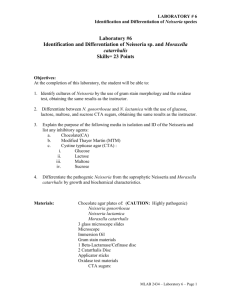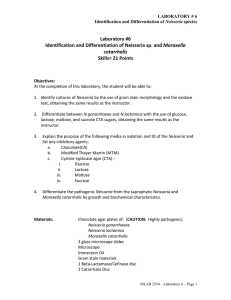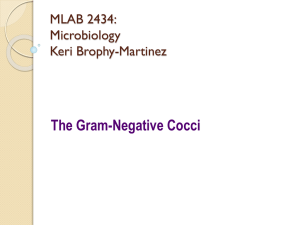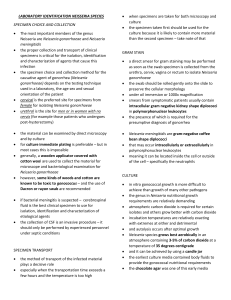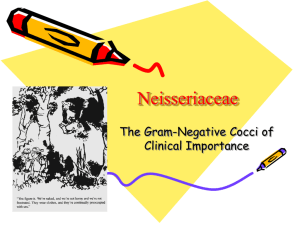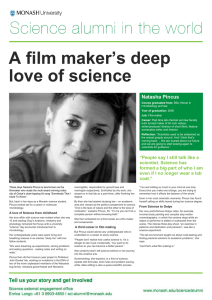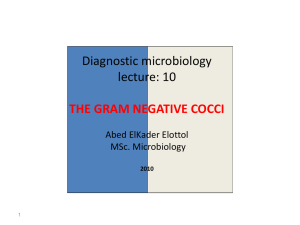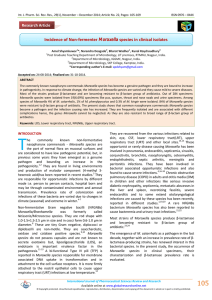Neisseria
advertisement
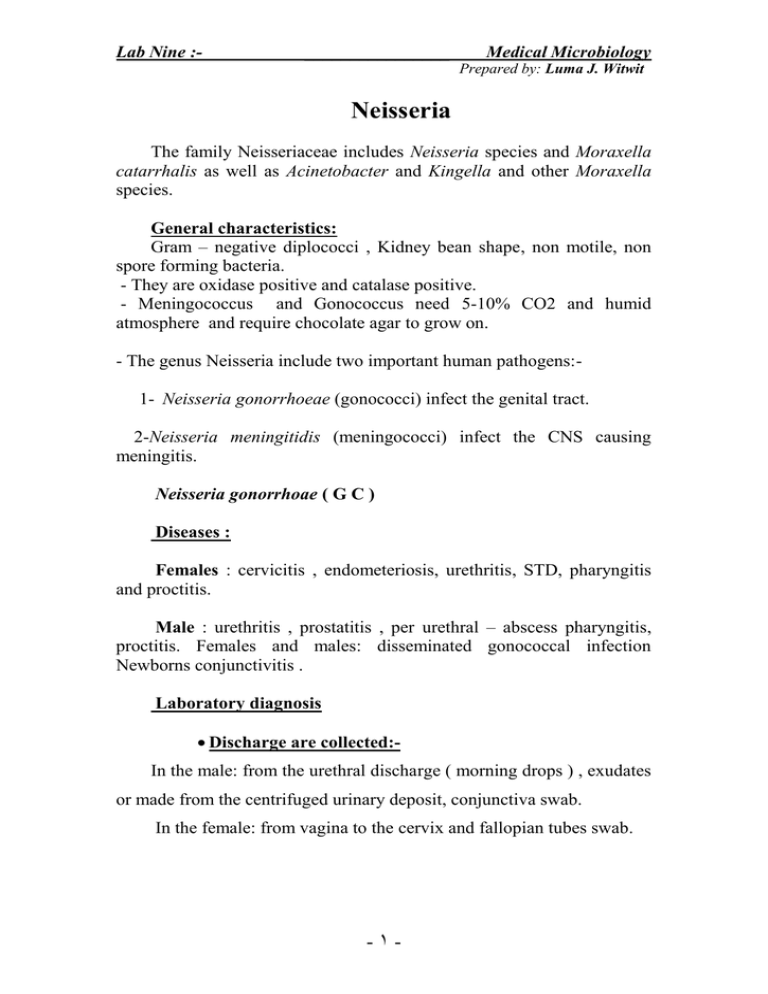
Lab Nine :- ________________ Medical Microbiology Prepared by: Luma J. Witwit Neisseria The family Neisseriaceae includes Neisseria species and Moraxella catarrhalis as well as Acinetobacter and Kingella and other Moraxella species. General characteristics: Gram – negative diplococci , Kidney bean shape, non motile, non spore forming bacteria. - They are oxidase positive and catalase positive. - Meningococcus and Gonococcus need 5-10% CO2 and humid atmosphere and require chocolate agar to grow on. - The genus Neisseria include two important human pathogens:1- Neisseria gonorrhoeae (gonococci) infect the genital tract. 2-Neisseria meningitidis (meningococci) infect the CNS causing meningitis. Neisseria gonorrhoae ( G C ) Diseases : Females : cervicitis , endometeriosis, urethritis, STD, pharyngitis and proctitis. Male : urethritis , prostatitis , per urethral – abscess pharyngitis, proctitis. Females and males: disseminated gonococcal infection Newborns conjunctivitis . Laboratory diagnosis Discharge are collected:In the male: from the urethral discharge ( morning drops ) , exudates or made from the centrifuged urinary deposit, conjunctiva swab. In the female: from vagina to the cervix and fallopian tubes swab. -1- Lab Nine :- ________________ Medical Microbiology Prepared by: Luma J. Witwit Gram stain :A direct Gram stain of urethra, cervix, rectum, conjunctival smears reveal *In male: sensitivity about 90%. *In female: sensitivity about 50% is due to the presence of normal flora in female urogenital tract. Gram stain of urethral exudate of a patient with gonorrhoea. Intracellular (within polymorphonuclear leukocytes) gram – negative diplococcic(Neisseria gonorrhoae) in clump are marked by the small arrows are diagnostic. *Culture of urethral exudates from male are not necessary when the stain is positive, but the cultures should be done for female. Specimen choice and collection:The specimen choice and collection method depends on the testing technique used in a laboratory and the age, sex and sexual orientation of the patient. Specimens should be collected with Dacron or rayon swabs because calcium alginate may be toxic to gonococci. Fatty acids inhibit the growth of gonococci; therefore, cotton swabs that do not list acceptable manufacturer specifications should not be used. To minimize the inhibitory effects of unknown substances in the specimen, the swabs should be inoculated directly onto growth medium or placed in swab transport medium immediately. Transport of specimens:- Methods of transportation vary with the specimen and the type of test being done, but in all instances when commercially available transport systems are used, the instructions provided by the manufacturer -2- Lab Nine :- ________________ Medical Microbiology Prepared by: Luma J. Witwit should be followed. Amies or Stuart madia are used as transportation media. Culture The primary specimens should be inoculated into nonselective chocolate agar and selective agar containing antimicrobial agents that inhibit the growth of commensal bacteria and fungi. The antibacterial agents in modified Thayer-Martin, Martin Lewis and New York City medium are vancomycin, colistin, trimethoprim lactate and the antifungal agents nystatin and neomycin or amphotericin B. After 48 hours Gonococci and meningococci from convex, glistening, elevated, mucoid colonies 1-5mm in diameter. Colonies are transparent or opaque, nonpigmented, and nonhemolytic. Neisseria flavescens, N. subflava, and N. lactamica have yellow pigmentation. N. sica produces opaque, brittle, wrinkled colonies. Moraxella catarhalis produces nonpigmented or pinkish- gray opaque colonies. Nucleic Acid Amplification Test:Detection of Gonococcal nucleic acid which causing DNA prob which can detect nucleic acid of microorganism. Serology;Serum and genital fluid contain IgG and IgA antibodies against gonococcal pilli, outer membrane proteins, and LPS. Some IgM of human sera is bactericidal for gonococci in vitro. -3- Lab Nine :- ________________ Medical Microbiology Prepared by: Luma J. Witwit Carbohydrate fermentation(N. gonorrhoae):Gonococcus is glucose fermenter and positive for hydroxyproline aminopeptidase . Surface structures include the following : 1- Surface structures include the following: A) Pili B) 3 Types of protein(POR,OPA,RMP)which important for adhesion. 2- Protease: is a major mucosal immunoglobulin of humans. Neisseria meningitides: The species have some of important virulence factors such as: 1- Antiphagocytic polysaccharide capsule . 2- Pilli ( colonization and antiphagocytic factor) . 3- Protease . Disease:Meningitis, Urethritis , Proctitis . Meningococcus is a common cause of meningitis in children (3 months to1 year old). and among young adult . Laboratory diagnosis: Meningococcus can ferment glucose and maltose sugar and it is positive for Y-glutamyl aminopeptidase . Other Neisseria sp. Neisseria sicca , Neisseria subfolava , N. flavescens , N. mucosa. They are part of the normal respiratory flora. N. catarrhalis ( Moraxella catarrhalis ) Disease:Bronchitis, pneumonia , sinusitis , conjunctivitis , meningitis . otitis media, female genital tract infection. -4- Lab Nine :- ________________ Medical Microbiology Prepared by: Luma J. Witwit Laboratory diagnosis:- Catalase and oxidase: positive. Negative for all carbohydrates: asaccharolytic. Negative for all enzymes. Biochemical test N.gonorrhoea Glucose Maltose Lactose Hydroxyproline aminopeptidase Ү-glutamyl aminopeptidase N. meningitidis N. catarrhalis + _ _ + + + _ _ _ _ _ _ _ + _ -5-
